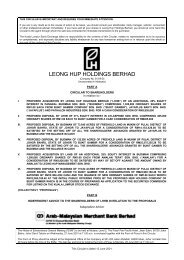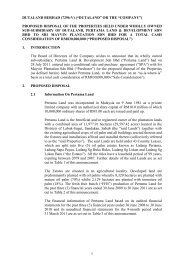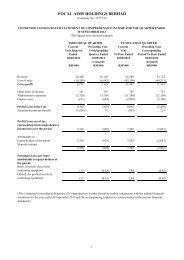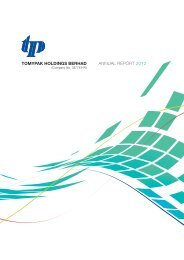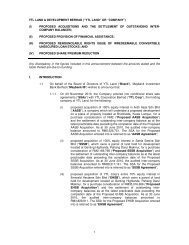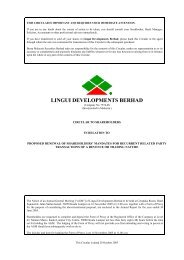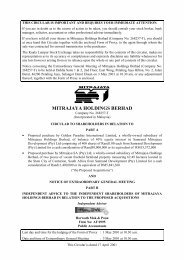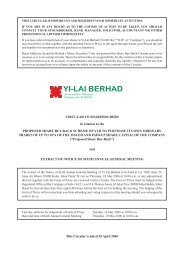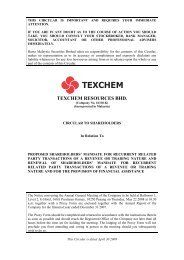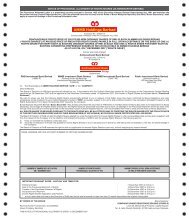MITRA-AnnualReport2011 (1.2MB).pdf - Announcements - Bursa ...
MITRA-AnnualReport2011 (1.2MB).pdf - Announcements - Bursa ...
MITRA-AnnualReport2011 (1.2MB).pdf - Announcements - Bursa ...
Create successful ePaper yourself
Turn your PDF publications into a flip-book with our unique Google optimized e-Paper software.
Notes to The Financial Statements (cont’d)<br />
2. SUMMARy of SIGNIfICANT ACCoUNTING polICIES (CoNT’D)<br />
2.3 Significant Accounting policies (cont’d)<br />
2.3.11 financial Assets (cont’d)<br />
The Group and the Company determine the classification of their financial assets at initial recognition, and<br />
the categories include financial assets at fair value through profit or loss, loans and receivables, held-tomaturity<br />
investments and available-for sale financial assets.<br />
(i) Financial assets at fair value through profit or loss<br />
Financial assets are classified as financial assets at fair value through profit or loss if they are held<br />
for trading or are designated as such upon initial recognition. Financial assets held for trading are<br />
derivatives (including separated embedded derivatives) or financial assets acquired principally for the<br />
purpose of selling in the near term.<br />
Subsequent to initial recognition, financial assets at fair value through profit or loss are measured at<br />
fair value. Any gains or losses arising from changes in fair value are recognised in profit or loss. Net<br />
gains or net losses on financial assets at fair value through profit or loss do not include exchange<br />
differences, interest and dividend income on the financial assets at fair value through profit or loss are<br />
recognised separately in the profit or loss as part of other losses or other income.<br />
Financial asset at fair value through profit or loss could be presented as current or non-current.<br />
Financial assets that are held primarily for trading purposes are presented as current or non-current<br />
based on the settlement date.<br />
(i) Loans and receivables<br />
Financial assets with fixed or determinable payments that are not quoted in an active market are<br />
classified as loans and receivables.<br />
Subsequent to initial recognition, loans and receivables are measured at amortised cost using the<br />
effective interest method. Gains and losses are recognised in profit or loss when the loans and<br />
receivables are derecognised or impaired, and through the amortization process.<br />
Loans and receivables are classified as current assets, except for those having maturity dates later<br />
than 12 months after the end of the reporting period which are classified as non-current.<br />
(iii) Held-to-maturity investment<br />
Financial assets with fixed or determinable payments and fixed maturity are classified as held-tomaturity<br />
when the Group has the positive intention and ability to hold the investment to maturity.<br />
Subsequent to initial recognition, held-to-maturity investments are measured at amortised cost<br />
using the effective interest method. Gains and losses are recognised in profit or loss when the heldto-maturity<br />
investments are derecognised or impaired, and through the amortization process.<br />
Held-to-maturity investments are classified as non-current assets, except for those having maturity<br />
within 12 months after the end of the reporting period which are classified as current.<br />
<strong>MITRA</strong>JAYA HOLDINGS BERHAD ANNUAL REPORT 2011<br />
51




